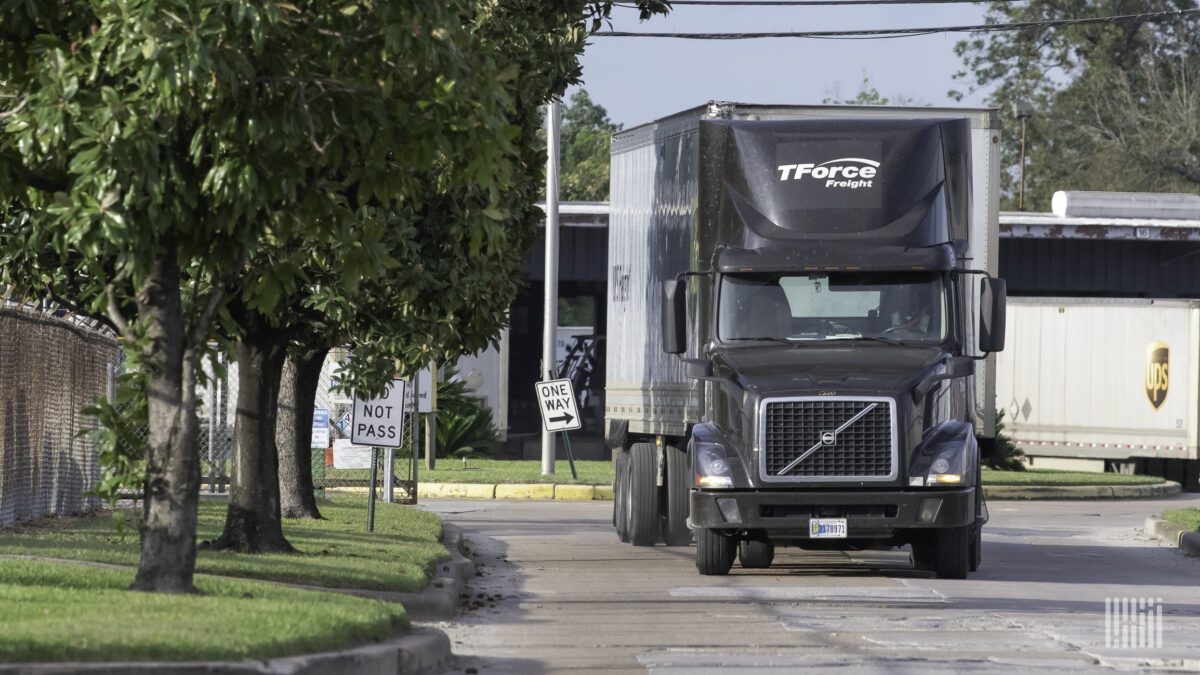TForce Freight pickup and delivery drivers will be driving fewer miles and picking up more freight per stop as part of TFI International’s efforts to improve operational efficiency in its U.S. LTL operations, CEO Alain Bédard said on Tuesday.
“Drivers, they like to drive. … Me, I like to pick up freight,” Bédard told financial analysts. “So we have a disconnect. So what we want to do is have our P&D guys drive less miles and pick up more freight.”
Bédard made the comments a day after Montreal-based TFI reported a 60% increase in profits during the fourth quarter versus a year ago — driven in part by improvements at TForce. The Canadian company brought in $144.1 million in adjusted net income — or $1.57 per share — on revenue of $2.1 billion.
TForce’s operating ratio hit 89.4%, its lowest level since TFI acquired UPS’ struggling LTL operation, UPS Freight, in April. But as Bédard made clear to analysts, TFI has far more aggressive ambitions: an operating ratio of 80% or lower.
By Bédard’s account, TForce has largely harvested the low-hanging fruit by shedding or repricing freight that wasn’t making money. TFI (NYSE:TFII) is now focusing on improving efficiency and density.
The CEO pointed to TFI’s Canadian LTL operation, which had an operating ratio below 80% in the last quarter — in a market with higher costs and lower rates than in the U.S.
“So our intention is to improve the efficiency of our network by picking up more freight and driving less miles,” he said. “And this is what we do in Canada. Why are we so efficient? It’s not because we’re a bunch of magicians. No, I mean we do more with less.”
In the fourth quarter, for instance, the Canadian LTL operation had an average shipment weight of just over 2,000 pounds versus 1,065 at TForce Freight. Meanwhile, the average length of haul in Canada, 791 miles, was nearly 30% less than TForce’s 1,110 miles.
TFI LTL by the numbers: U.S. versus Canada
| Q4 2021 | U.S. | Canada |
| Shipments (in thousands) | 1,829 | 684 |
| Weight per shipment | 1,065 lbs | 2,006 lbs |
| Tonnage (in thousands) | 974 | 650 |
| Revenue per hundredweight | $29.20 | $11.13 |
| Revenue per shipment | $310.97 | $223.30 |
| Length per haul | 1,110 miles | 791 miles |
| Operating Ratio | 89.4% | 78.3% |
Bédard said TFI is working to address inefficiencies in TForce’s network, particularly with pickup and delivery operations. It involves getting “more freight at every stop” and reducing the amount of driving — with the aim of cutting costs and making those trucks more productive.
“We have guys driving 150 miles. OK, that doesn’t make any sense, though. Because if this guy drives up to 40 miles an hour, that means that he’s driving about three to four hours a day. So when he’s driving, he’s not picking up freight. And when he’s driving, he’s spending money. He’s burning fuel, he’s burning tires.”
TFI is also continuing to cut costs associated with TForce Freight terminals, after closing several smaller facilities. The company also plans to lease out parts of underutilized terminals, with a focus on the West Coast, Bédard said.
Delays in truck orders, meanwhile, mean that TForce is continuing to rely on old equipment. Bédard noted that maintenance costs are 45 cents per mile for its older trucks.
As TFI continues to make strides at TForce, its truckload business is having some struggles. TFI’s conventional truckload segment lagged behind the rest of the company, with profits growing by just 12% versus a year ago.
The issue is largely in the U.S., where TFI has consolidated its truckload operations into CFI. In the fourth quarter, the U.S. truckload segment’s operating ratio reached 95.5%, with much of the headwinds coming from former dedicated operations of TForce Freight and Transport America.
The TForce dedicated business had been operating at a loss, something that Bédard expects will end in the first quarter.
“Our truckload guys are working diligently to improve what we have now because for sure, showing the results that we have today in our Q4 compared to our peers in the U.S., we’re a little bit concerned,” Bédard said.
Watch now: Will we continue to see record earnings for trucking companies?
Read more
- TForce Freight drivers win small victory in truck speed fight
- TFI to close ex-UPS Freight terminals to rein in costs
- Teamsters fight TForce Freight truck slowdowns
Click for more FreightWaves articles by Nate Tabak
The FREIGHTWAVES TOP 500 For-Hire Carriers list includes UPS (No. 2).











